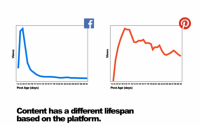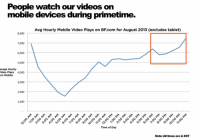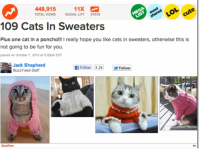Das folgende Video sollte für jeden Social Media Manager ein Pflichtvideo sein. Die Macher hinter Buzzfeed, einem der größten Listicle-Portale, erklären in einem sehr anschaulichen Video, wie ihre Nutzer die Social Media Kanäle nutzen und wie sich das wiederum auswirkt auf den Content.
Ein Beispiel: 30 Tage vor Halloween beginnt Buzzfeed Kürbisrezepte auf Pinterest zu posten, aber erst 2 Tage vor Halloween wird der gleiche Content auf die Facebook-Seiten von Buzzfeed gepostet. Warum? Hier sehen wir den Unterschied zwischen der Mediennutzung auf Facebook und Pinterest:
 Während Facebook-Content nur 1-2 Tage richtig verbreitet, verteilt sich Pinterest-Content über mehrere Tage und Wochen.
Während Facebook-Content nur 1-2 Tage richtig verbreitet, verteilt sich Pinterest-Content über mehrere Tage und Wochen.
Ein weiteres Diagramm, welches sehr aufschlußreich ist, ist die Videonutzung. Bei Buzzfeed werden die meisten Videos parallel zur Primetime angeschaut – nicht vor oder nach dem Hauptfernsehen, sondern zeitgleich.
Und eine weitere spannende Nachricht bezieht sich auf Katzen. Die Kollegen bei Buzzfeed sagen, dass Katzen-Listen sehr gut funktionieren, aber nur wenn die Listen die Staffelage für eine Geschichte bilden. Listen einfach so bringen überhaupt nichts.
Am besten bringt es Wil Reynold auf den Punkt – er beschreibt die einzelnen Lektionen des Videos sehr genau:
The meat doesn’t start until about 4:50 if you ask me so that gives you back some.
4:50 – 5:38 – Talks about what kind of content works on what channels
Big takeaway – facebook vs twitter in terms of what takes off where.
Interesting that they find that people on twitter like to feel like they are the first to know/break something vs facebook is more or less things you think you friends would want to know
Reminder people share things that make them feel intelligent / in the know.5:39 – 6:00 – Pinterest tends to be the content that revolves around what people aspire to be, great cook, have a great wedding, get ideas that inspire you, or connect with what you want to become.
Skip to 7:29 (look at the graph) – A post on facebook tends to have a 7 day life span, if it is GOOD content. Pinterest has a long tail impact, making the rounds through re-pinning, twitter is more like 24-48 hour lifecycle.
7:30 – 8:00 – Talks about the timing of content, for thanksgving content Buzzfeed starts its pinterest campaigns over a month in advance, and then a week before they started posting to facebook.
skip to 9:30 – Just look at the graphic – they remind us that TV competes with social video, since so much of it is viewed at primetime.
skip to 14:33 – look at the starbucks example and toms example – we should talk less about attributes, but more about what people aspire to if you want something to take. That is the point, you don’t have to watch them all, but its not a bad example.
skip to 18:15 watch until 19:35
Planned spontenatey is SUPER SMART – they created 2 posts BEFORE the superbowl, it is inevitable that one team will lose, so they wrote a post on why you should still be happy even if your team loses, and launched it the next day. They then showed how volkswagen tied this into an ongoing get happy strategy.
Skip until at least 32:18 unless you want to learn about just pop culture stuff, but most of it isn’t valuable unless you had a pop culture client like a celebrity client or just want to understand virality, but for 95% of us this won’t help you do anything better in your job, but it is fun to just watch if you ain’t busy.
32:18 – 33:23 some interesting ways to get people to relate to something that is about their self identity / world views and how you want people to see you. Check out the gay marriage in minnesota example, the you’ll only get this joke if you are super smart, the ones that connect with age are interesting, but less useful. After that they get to location stuff, which I think won’t help most of you, but was interesting to watch if you have more time.


